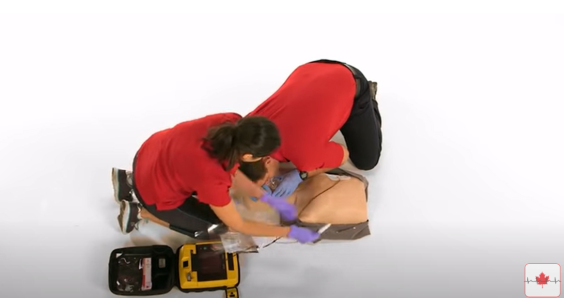The disturbing on-field collapse of NFL star Damar Hamlin during a televised game Monday night shocked viewers, commentators and the sports world.
Seconds after taking a hit in a game against the Cincinnati Bengals, the 24-year-old Buffalo Bills player fell backwards and lay still. Medical experts rushed onto the field to revive him. An ambulance transported him to hospital, where he was stabilized but remains in critical condition.
The Bills later tweeted that he had suffered a cardiac arrest and that his heartbeat had been restored on the field.
The incident prompted a number of cardiologists to speculate online that the cause of the arrest may have been something called commotio cordis, which is Latin for “disruption of the heart.”
St. Paul’s Hospital and Vancouver General cardiac electrophysiologist Dr. Jason Andrade took to Twitter after the disturbing incident with general information about commotio cordis.
Dr. Andrade, who is also Medical Chair of the Heart Rhythm Disease – BC Cardiovascular Disease Network, offers insights into what it is, how it is caused and how prevalent it is.

Q: What is commotio cordis?
A: Commotio cordis is a type of arrhythmia caused by a high-force, traumatic blow to the chest overlying the heart. The trauma has to be of sufficient force and hit the heart at a vulnerable time during its electrical cycle. If it hits at the right moment in the heart’s electric cycle, it can trigger that arrhythmia and a subsequent cardiac arrest.
Q: What is the incidence?
A: It is extremely rare, although it is likely underreported. The best estimate we have is from the U.S. commotio cordis registry, which adds about 20 cases each year.
Q: When is it most likely to occur?
Commotio cordis is typically seen a sports context, where athletes are more at risk of trauma. In the United States, it predominates in baseball or football, the most common American sports. Outside of that country, it occurs more commonly in soccer, for instance if the ball strikes the chest. It can take place in hockey, too, if a puck strikes the chest. (Former NHL defenceman) Chris Pronger suffered a brief cardiac arrest from commotio cordis when a puck hit him in the chest (during the 1998 Stanley Cup playoffs).
If it occurs within that very specific window of the heart’s electric cycle, it can trigger the arrhythmia and cardiac arrest. In Hamlin’s case, it seems to have been the result of a perfect storm of circumstances.
Q: Who is most at risk?
Commotio cordis occurs more frequently in younger people, and in particular young men. This is because the chest bones (the ribs and sternum) that are more malleable, and therefore more likely to translate the force of impact directly to the heart. As we age, our bones tend to fuse and become less compliant, so there is less chance of the traumatic force carrying through directly to the heart.
Q: How survivable is it?
A: The survival rate is relatively low, being between 20 to 50 per cent. Early recognition is very important, in order to get aid to the person as quickly as possible. The longer it takes to resuscitate someone, the lower the likelihood of a successful resuscitation will be successful, and the higher the risk of associated injury, such as anoxic brain injury and other problems related to a lack of a pulse for an extended period.
If electroshock (from automated external defibrillators, or AED) is administered, it is highly survivable.
(A JAMANetwork paper from 2002 found that in a small sample of those who suffered the condition, only 16 per cent survived, and of those, 90 per cent had received resuscitative measures for cardiac arrest).
Q: While this is speculation on your part, is there a chance Hamlin’s arrest could have been triggered by an underlying heart condition?
A: His doctors would be considering everything that could have caused the cardiac arrest. As he is a professional athlete, it is most likely that he would have undergone extensive medical screening to rule out pre-existing problems, though some can be unrecognised despite extensive testing. I’m sure that the physicians caring for him will be undertaking an extensive evaluation of inherited and acquired conditions that predispose people to cardiac arrest.
Q: What is your message to people from this event?
A: Most people do not survive an out-of-hospital cardiac arrest. As a population, the biggest impact we can have to improve the outcomes of patients experiencing an out-of-hospital cardiac arrest is to ensure they receive prompt CPR, and that automated external defibrillators (AEDs) are widely available. AEDs are designed to be used by anyone and don’t require special training, so ensuring that they are available to people in cardiac arrest is incredibly important.

To learn more about CPR and AED techniques, view these videos.
From Heart & Stroke: https://www.youtube.com/watch?v=fNrYleMreUU
From the Canadian Red Cross: https://www.youtube.com/watch?v=9FefKQkMYJg (CPR) https://www.youtube.com/watch?v=2BlCvIu9bHg (CPR and AED)
As told to Ann Gibbon





